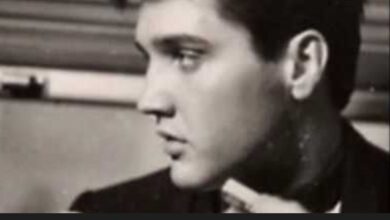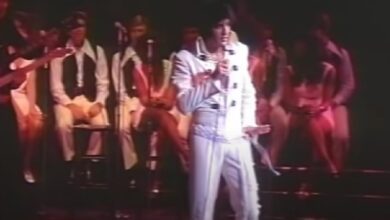I Could Watch This Performance Over And Over Without Ever Getting Tired
The ’68 Comeback Special, which aired on December 3, 1968, on NBC, marked a defining moment in the legacy of Elvis Presley, who had been largely absent from the concert stage since the mid-1960s. This special not only reignited his career after a period of stagnation but also served as a cultural touchstone that reintroduced him to a new generation of fans while reaffirming his influence on those who had long admired him. The event was innovative, featuring a blend of performances interspersed with intimate moments and interviews, thereby showcasing the man behind the legend in a way that had not been seen before.
Elvis’s performances were notable for their heartfelt emotion and stage presence. In one particularly striking segment, he delivered a powerful rendition of “If I Can Dream,” a socially conscious song that reflected the tumultuous climate of the late 1960s. The soulful fervor of the performance signified not just a personal comeback but also a broader response to the societal issues of the time. This number poignantly encapsulated Elvis’s ability to merge his musical artistry with the zeitgeist of the era, demonstrating his awareness and sensitivity to the world around him.
The special highlighted Elvis’s evolution as an artist. Gone was the purely rock and roll image; what emerged was a more complex figure capable of crossing genres and embracing different musical styles, including gospel, blues, and even the emerging trends of the rock music scene. A performance of “Trouble” showcased this versatility. The song’s driving rhythm and Elvis’s powerful vocals provided a captivating experience, reinforcing his ability to connect with contemporary sounds while maintaining his individuality.
In addition to his solo performances, the special also featured Elvis in collaboration with the famous musicians of the time. By engaging in performance duets and group numbers, he demonstrated his adaptability and ability to harmonize with various styles. This interactive aspect of the show allowed viewers to see the chemistry Elvis had not only with his bandmates but also with the audience, establishing an electric atmosphere that was palpable through the screen.
The staging of the ’68 Comeback Special was carefully crafted to enhance the emotional resonance of each performance. The use of different sets, including an intimate sit-down segment and a lively stage show, created a contrast that kept the audience engaged. This design emphasized the duality of Elvis’s persona: the vulnerable artist and the larger-than-life entertainer. The interplay of lighting, camera angles, and sound further ensured that Elvis’s magnetic charisma shone through in every frame.
Elvis’s connection to his audience was further exemplified through the candid moments interspersed throughout the show. Clips of Elvis reminiscing about early performances and discussing his passions lent an authentic dimension to the spectacle. These unscripted interactions fostered a sense of intimacy between Elvis and the viewers, inviting them into his world and emphasizing his humanity. This was an aspect that often got lost in the glitz of rock and roll stardom but was crucial for reshaping public perception of him at the time.
The influence of the ’68 Comeback Special reached far beyond its initial airing. It reinvigorated Elvis’s career, leading to a series of successful recordings and live performances in the years that followed. His return to the stage established a blueprint for future televised concerts and specials, paving the way for artists to interact with fans in innovative ways. The show became a cornerstone for musicians to launch and revitalize their careers, proving the power of live performance even in an evolving media landscape.
After the success of the special, Elvis continued to embrace new challenges, including acting in films that softened his image and aligned with contemporary themes. However, the moment captured during the ’68 Comeback Special served as a reminder of his roots and the profound impact of his early work. It represented a bridge from his past as a youthful rock and roll rebel to a seasoned artist capable of profound emotional expression and musical innovation.
Elvis Presley’s biography is rich with milestones. He was born on January 8, 1935, into modest beginnings, growing up in a single-parent household after his father was imprisoned. His family moved to Memphis, Tennessee, where he absorbed various musical influences ranging from gospel, blues, country, and pop. After recording his first single in 1954, he skyrocketed to fame, becoming a cultural phenomenon who was often credited with helping to bring rock and roll into the mainstream.
As he navigated the complexities of fame, Elvis faced personal challenges, including struggles with fame’s pressures and his battle with substance abuse, which would later affect his career. Nevertheless, the essence of his music remained influential. Elvis’s dedication to his craft and his ability to evolve musically and personally underscored his status as an icon. His legacy is not merely in the countless records sold but in his ability to reach out and touch the hearts of listeners worldwide through his powerful performances and deeply felt music.
In sum, the ’68 Comeback Special symbolizes more than just a return for Elvis Presley. It reflects the resilience of an artist who not only remained relevant in changing times but also offered a fresh perspective on his enduring legacy. By bridging the gap between generations of fans and showcasing his unique artistry, Elvis proved that he could continually reinvent himself while keeping the essence of who he was at the core, ultimately solidifying his status as the “King of Rock and Roll.” Through the special and the multitude of performances it featured, viewers witnessed a defining moment in not just Presley’s career but in the landscape of American music itself.



